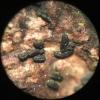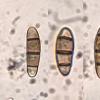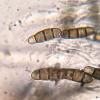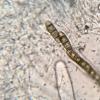
20-12-2025 23:08
Patrice TANCHAUDBonsoir, récolte sur sol sablonneux dans l'arri�

21-12-2025 09:32
Hello.A tiny ascomycete found embedded in wood in

20-12-2025 15:47
Mirek GrycHi.These grew on pine wood that was heavily covere

18-12-2025 21:17
Pol DebaenstThe identification took me to Byssonectria deformi

15-12-2025 07:09
 Danny Newman
Danny Newman
indet. Rutstroemiaceae sp. on unk. fallen leavesMc

19-12-2025 10:10
Patrice TANCHAUDBonjour, récolte réalisée en milieu dunaire, a

18-12-2025 17:23
 Bruno Coué
Bruno Coué
Bonjour,je serais heureux d'avoir votre avis sur c
Hysterium pulicare (?)
Ethan Crenson,
04-04-2018 16:05
From Bronx NYC, Pelham Bay Park on Picea. Am I correct that this is Hysterium pulicare? Ascospores are brown, 3-septate, (18) 21-24 by 6-8µm. The end cells of most spores are lighter brown (a few almost hyaline) than the median cells.
The difference between H. angustatum and H. pulicare in Boehm's key depends on this feature: "terminal cell mainly remaining hyaline". He also writes that ~10% of ascospores of H. pulicare are typically found to be concolorous; and ~5% of ascospores of H. angustatum are found to be versicolorous.
Ascospore size for H. pulicare is worth mentioning as well. H. pulicare ascospores can reach up to 40µm in length according to Boehm and Zogg. I did not observe anything approaching 40µm.
So my questions regarding my collections boil down to: Are the end cells light enough to place it in H. pulicare? Does the absence of ascospores in the larger range (near 40µm) eliminate H. pulicare as a possibility?
Thanks in advance!




